- Home
- Garden Wildlife
- Insects
- True flies
- Houseflies and worse
Houseflies, blow, flesh and dung flies
This is a bit of a rag-bag group of flies within the super families Oestroidea (blow flies and flesh flies) and Muscoidea (house flies and dung flies). There are also the black scavenger dung-eating flies in the Family Sepsidae. If they have one thing in common, it would be that they are all considered unpleasant, disease-carrying nuisances, but they are vital in recycling dead material.
Species in Britain and Ireland
Blow flies are members of the Calliphoridae: the name ironically meaning "bearer of beauty", perhaps because some (bluebottles, greenbottles) are shiny-metallic and quite colourful. There are 37 species in Britain and Ireland, and they include important forensic corpse consumers, myiasis agents (fly maggots living parasitically within living tissue) and consumers of putrefying waste. The cluster flies also belong in this family but have comparatively less unpleasant habits, being parasitoids of earthworms. Jennifer Owen recorded 9 species in her garden study.
Calliphora vomitoria is the bluebottle fly. They can be found at almost any time of year, and the maggots feed on decaying animal matter and faeces. They grow extremely fast before pupating, and the whole cycle lasts less than a month. The larvae are cultivated as fishing bait and sold as "gentles", while pupae are called "casters".
.jpg)
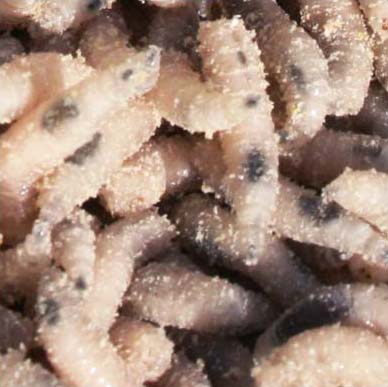
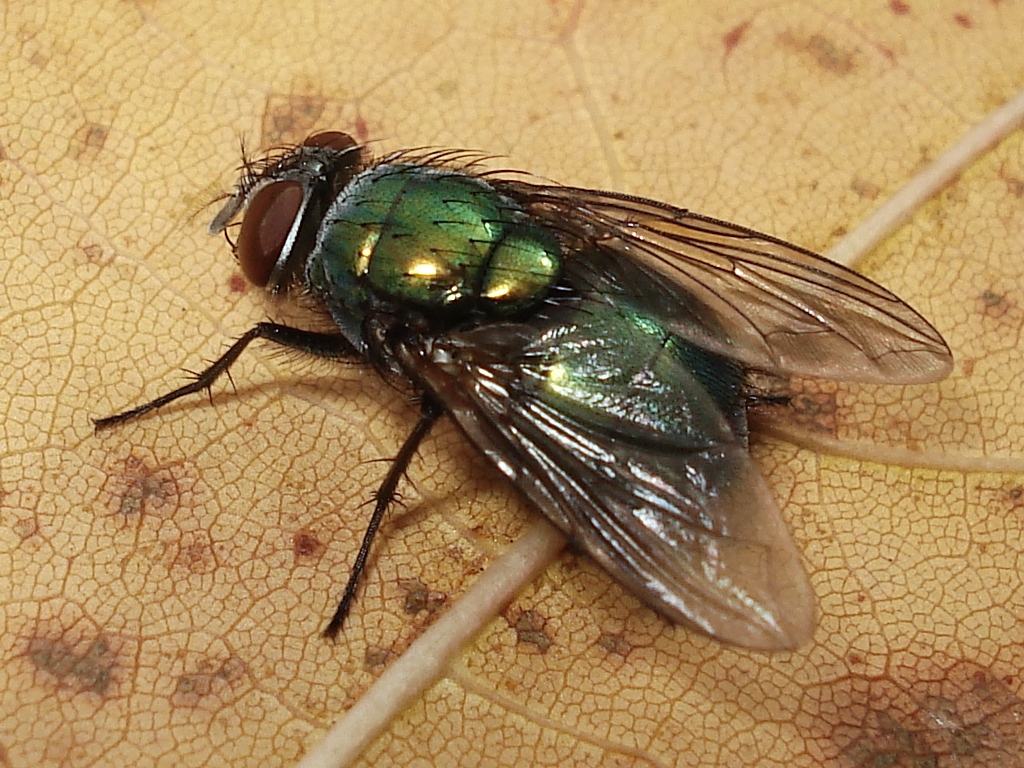
Bluebottle Calliphora vomitoria adult Bluebottle maggots reared as bait Greenbottle Lucilia caesar adult
The greenbottle fly Lucilia caesar is one of several similar green flies visiting flowers, human food, decaying material and faeces to drink fluid as an adult. The common related fly Lucilia sericata can lay its eggs in sheep wool, and the emerging larvae burrow into and feed under the skin of the sheep, causing unpleasant and dangerous lesions known as sheep-strike.
Flesh flies are members of the family Sarcophagidae. There are 63 British and Irish species in this family, and Jennifer Owen found 6 species in her garden from three genera. An unusual feature of the family is that the female partially broods the eggs in her body, and they are laid as minute larvae. A common garden species is Sarcophaga carnaria which feeds on carrion. Brachicoma devia occur in bumblebees and wasp nests.
Housefly Musca domestica, mating adults and maggot. Right: Mesembrina meridiana
Dung flies are in the family Scathophagidae which means dung-eaters, although only 5 or 6 of the 55 species in Britain and Ireland have this habit. The yellow dung-fly Scathophaga stercoraria is a common garden resident feeding on dung where it can find it. It also seems to enjoy (or at least is attracted to as an adult) stinking anaerobic rotting plant material in neglected buckets.
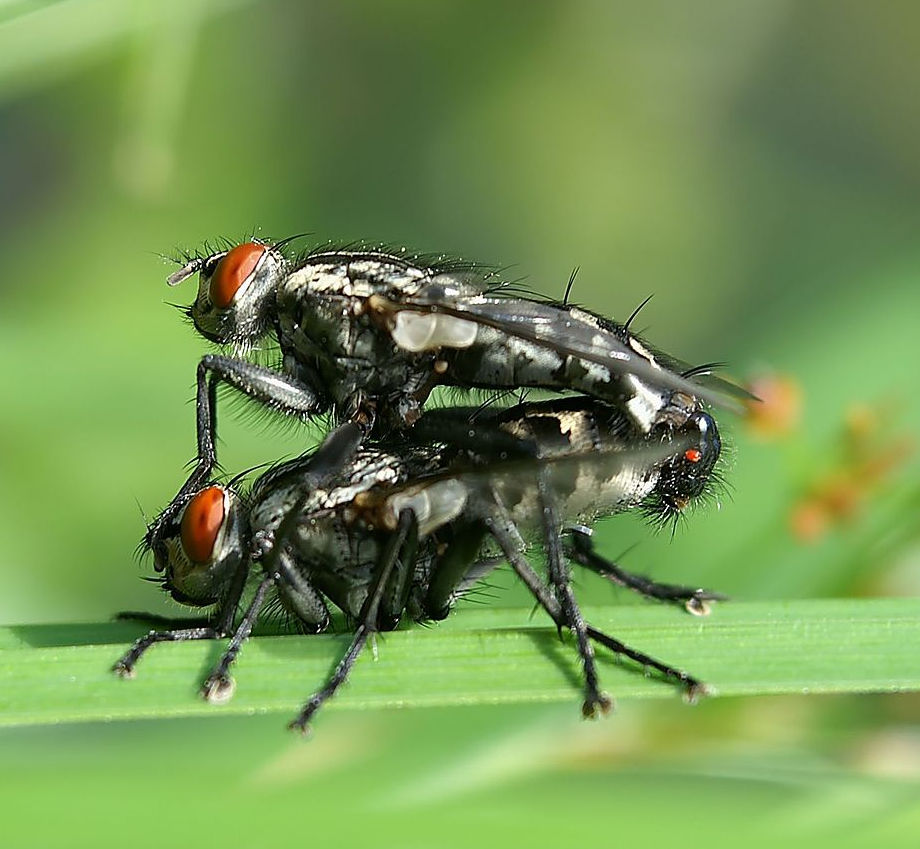
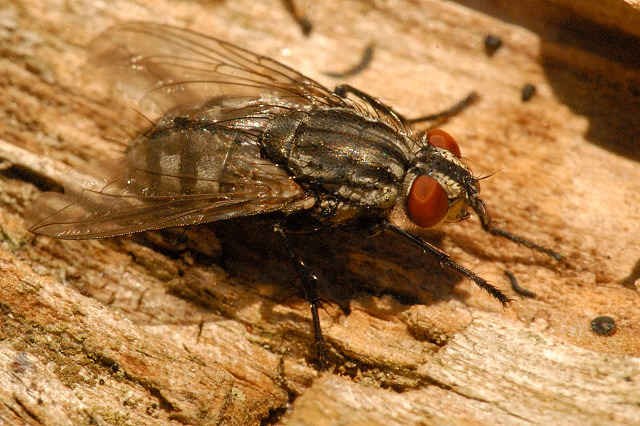
Flesh flies: Mating pair of Sarcophaga carnaria Brachicoma devia
House flies are members of the family Muscidae of which there are 287 species in Britain and Ireland. Some well known species are synanthropic and the housefly Musca domestica is thought to have evolved in the middle-east, and spread from there with humans all over the world. Like other flies on this page, houseflies lay eggs on decaying organic waste, faeces and carrion in which the maggot larvae thrive grow and metamorphose very quickly. The adult flies feed on liquid, and solids which they soften with saliva. This spitting, when it happens on our food, is a source of disease spread. Mesembrina meridiana is a common garden muscid fly recorded by Jennifer Owen, often seen nectar-feeding as a adult, and which lays eggs in cattle or horse dung,
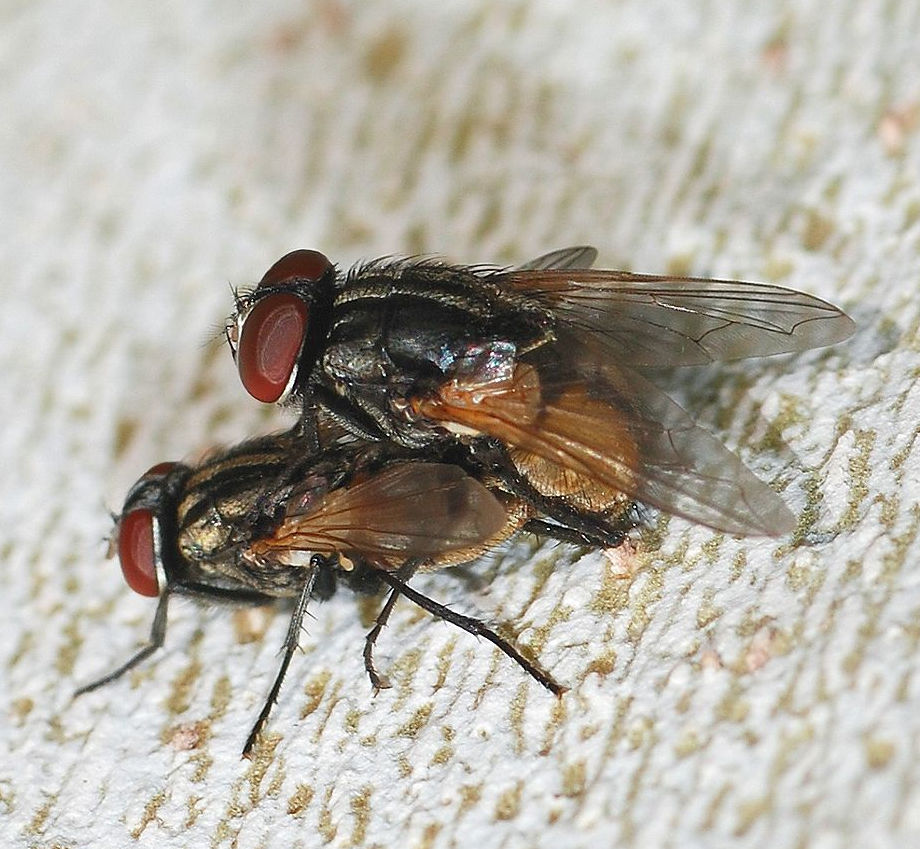
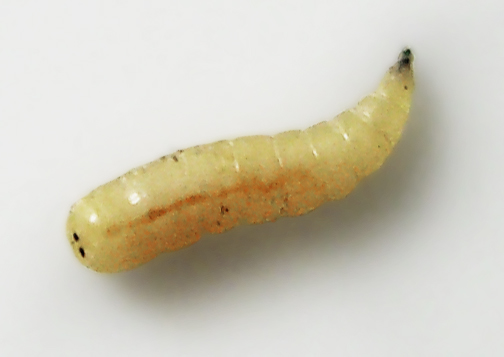
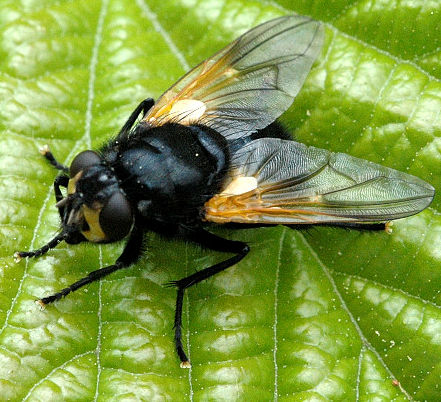
![Yellow dung fly Scathophaga stercoraria male Photo: By No machine-readable author provided. Svdmolen assumed (based on copyright claims). [CC BY-SA 3.0 (http://creativecommons.org/licenses/by-sa/3.0/)]](images/1280px-Scathophaga_stercoraria-01_(xndr).jpg)
Role of these flies in gardens
These flies are extremely important decomposers of rotting animal matter in our gardens, and the adults contribute to pollination. If the reader feels this is enough to overcome the more repellent aspects of these flies, all the better.
Other sources of information
Websites
Steven Falk's information and pictures of Calliphoridae
Mikesinsectkeys2 Mike Hackston Keys to identify British Muscidae
Books
d'Assis Fonseca, E.C.M. (1968) Handbooks for the Identification of British InsectsVol 10 Part 4b. Diptera - Cyclorrhapha Calyptrata, Section (b) Muscidae. Out of print, available here
Pont, A.C. (1979) RES Handbooks for the identification of British Insects. Volume 10 part 5(c). Sepsidae - Siptera: Cyclorrhapha, Acalyptrata.
Page drafted and compiled by Steve Head
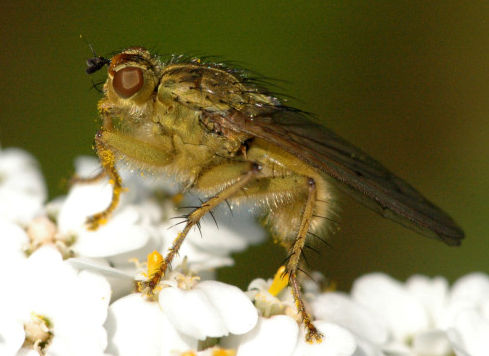
Yellow dung-fly Scathophaga stercoraria. Male (left) is brightly yellow, while the female (right) which is less often seen is less hairy and more green-grey.

Large numbers of male yellow dung flies swarming over an upturned bucketful of rotting plant remains which certainly smelled at least as bad as if not much worse than fresh dung.
The black scavenger dung flies are in the family Sepsidae. They are also known as ensign flies, and will feed as larvae on rotting vegetation as well as dung. They are rather ant-like, with a "waist " between thorax and abdomen. As with some other flies, males tend to congregate in mating swarms, indulging in displays of wing-waving. Some have black wing spots that make the waving more distinctive. Sepsis punctum (below) is one species commonly seen at flowers.
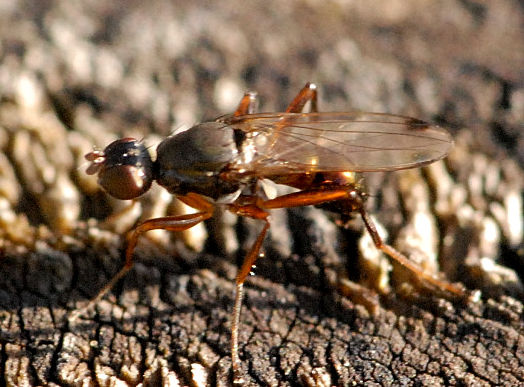
Houseflies, blow, flesh and dung flies
This is a bit of a rag-bag group of flies within the super families Oestroidea (blow flies and flesh flies) and Muscoidea (house flies and dung flies). There are also the black scavenger dung-eating flies in the Family Sepsidae. If they have one thing in common, it would be that they are all considered unpleasant, disease-carrying nuisances, but they are vital in recycling dead material.
Species in Britain and Ireland
Blow flies are members of the Calliphoridae: the name ironically meaning "bearer of beauty", perhaps because some (bluebottles, greenbottles) are shiny-metallic and quite colourful. There are 37 species in Britain and Ireland, and they include important forensic corpse consumers, myiasis agents (fly maggots living parasitically within living tissue) and consumers of putrefying waste. The cluster flies also belong in this family but have comparatively less unpleasant habits, being parasitoids of earthworms. Jennifer Owen recorded 9 species in her garden study.
Calliphora vomitoria is the bluebottle fly. They can be found at almost any time of year, and the maggots feed on decaying animal matter and faeces. They grow extremely fast before pupating, and the whole cycle lasts less than a month. The larvae are cultivated as fishing bait and sold as "gentles", while pupae are called "casters".
.jpg)


The greenbottle fly Lucilia caesar is one of several similar green flies visiting flowers, human food, decaying material and faeces to drink fluid as an adult. The common related fly Lucilia sericata can lay its eggs in sheep wool, and the emerging larvae burrow into and feed under the skin of the sheep, causing unpleasant and dangerous lesions known as sheep-strike.
Flesh flies are members of the family Sarcophagidae. There are 63 British and Irish species in this family, and Jennifer Owen found 6 species in her garden from three genera. An unusual feature of the family is that the female partially broods the eggs in her body, and they are laid as minute larvae. A common garden species is Sarcophaga carnaria which feeds on carrion. Brachicoma devia occur in bumblebees and wasp nests.
Top left: Bluebottle Calliphora vomitoria adult Right: Bluebottle maggots reared as bait
Left: Greenbottle Lucilia caesar adult



Dung flies are in the family Scathophagidae which means dung-eaters, although only 5 or 6 of the 55 species in Britain and Ireland have this habit. The yellow dung-fly Scathophaga stercoraria is a common garden resident feeding on dung where it can find it. It also seems to enjoy (or at least is attracted to as an adult) stinking anaerobic rotting plant material in neglected buckets.
Top left: Housefly Musca domestica, mating adults and Right: maggot.
Left: Mesembrina meridiana

Large numbers of male yellow dung flies swarming over an upturned bucketful of rotting plant remains which certainly smelled at least as bad as if not much worse than fresh dung.
![Yellow dung fly Scathophaga stercoraria male Photo: By No machine-readable author provided. Svdmolen assumed (based on copyright claims). [CC BY-SA 3.0 (http://creativecommons.org/licenses/by-sa/3.0/)]](images/1280px-Scathophaga_stercoraria-01_(xndr).jpg)

Yellow dung-fly Scathophaga stercoraria. Male (left) is brightly yellow, while the female (right) which is less often seen is less hairy and more green-grey.
The black scavenger dung flies are in the family Sepsidae. They are also known as ensign flies, and will feed as larvae on rotting vegetation as well as dung. They are rather ant-like, with a "waist " between thorax and abdomen. As with some other flies, males tend to congregate in mating swarms, indulging in displays of wing-waving. Some have black wing spots that make the waving more distinctive. Sepsis punctum (below) is one species commonly seen at flowers.

Role of these flies in gardens
These flies are extremely important decomposers of rotting animal matter in our gardens, and the adults contribute to pollination. If the reader feels this is enough to overcome the more repellent aspects of these flies, all the better.
Other sources of information
Websites
Books
d'Assis Fonseca, E.C.M. (1968) Handbooks for the Identification of British InsectsVol 10 Part 4b. Diptera - Cyclorrhapha Calyptrata, Section (b) Muscidae. Out of print, available here
Pont, A.C. (1979) RES Handbooks for the identification of British Insects. Volume 10 part 5(c). Sepsidae - Siptera: Cyclorrhapha, Acalyptrata.
Page drafted and compiled by Steve Head


Flesh flies: Mating pair of Sarcophaga carnaria Brachicoma devia
House flies are members of the family Muscidae of which there are 287 species in Britain and Ireland. Some well known species are synanthropic and the housefly Musca domestica is thought to have evolved in the middle-east, and spread from there with humans all over the world. Like other flies on this page, houseflies lay eggs on decaying organic waste, faeces and carrion in which the maggot larvae thrive grow and metamorphose very quickly. The adult flies feed on liquid, and solids which they soften with saliva. This spitting, when it happens on our food, is a source of disease spread. Mesembrina meridiana is a common garden muscid fly recorded by Jennifer Owen, often seen nectar-feeding as a adult, and which lays eggs in cattle or horse dung,












